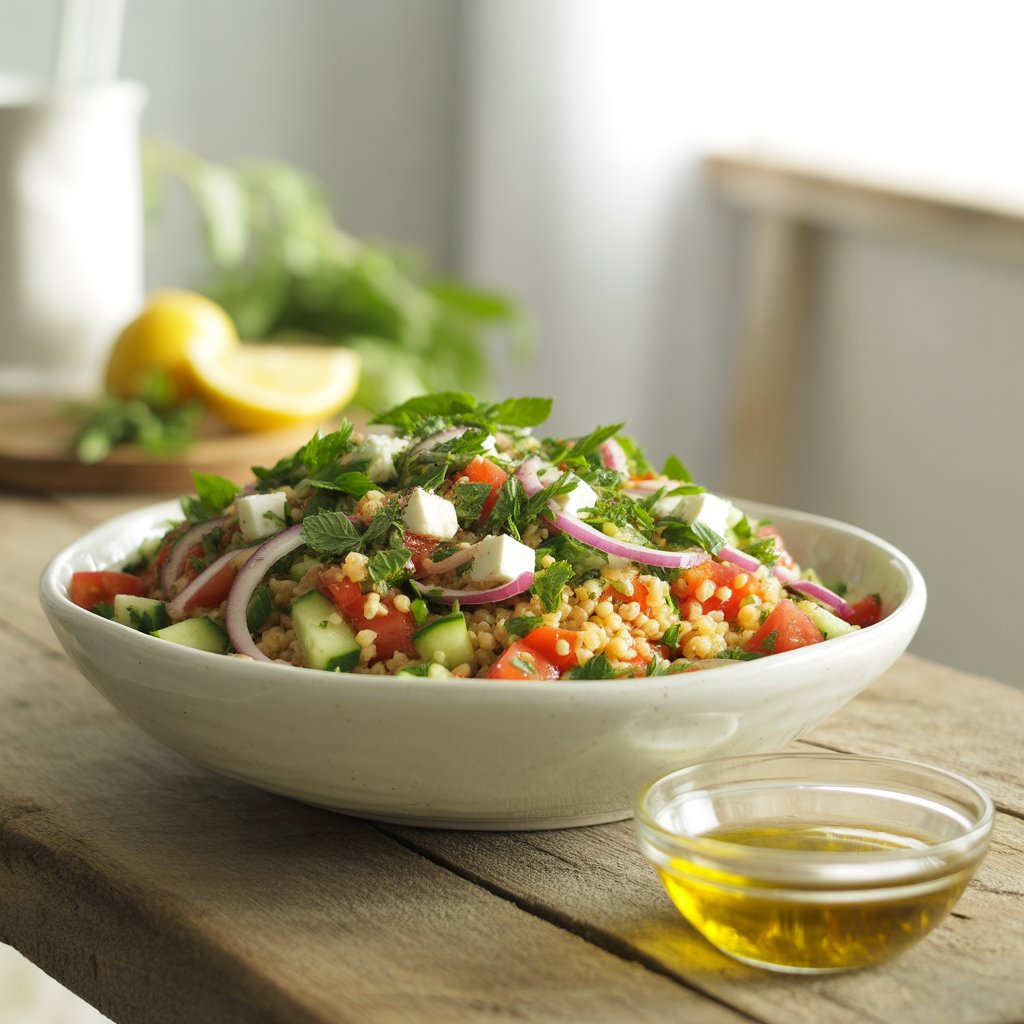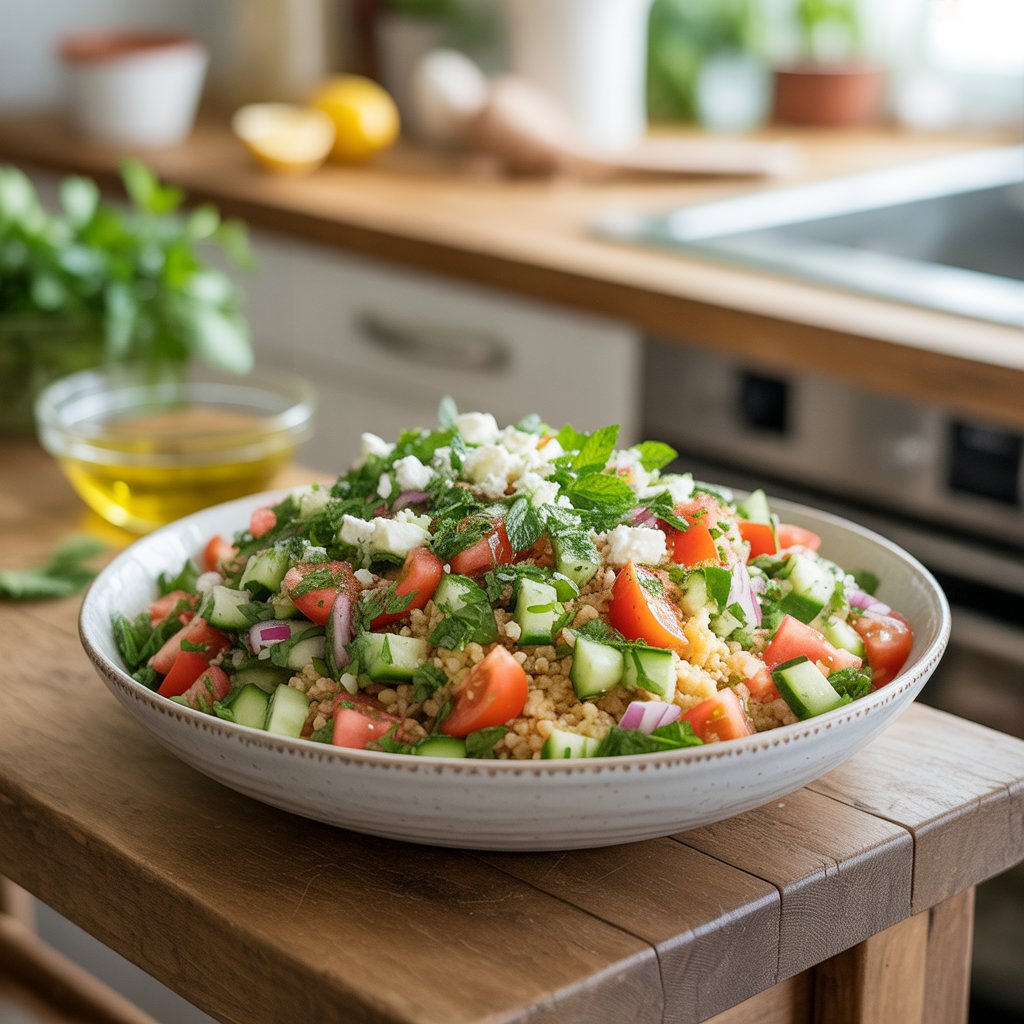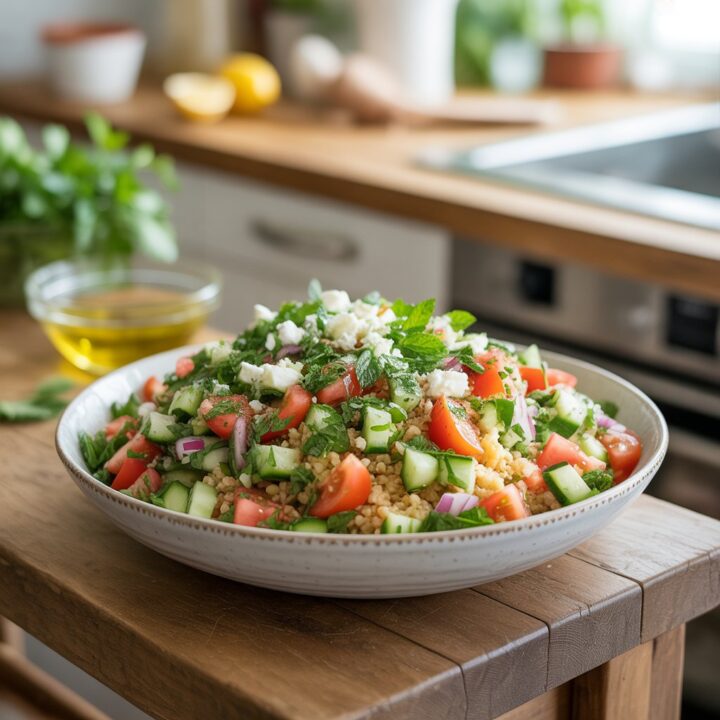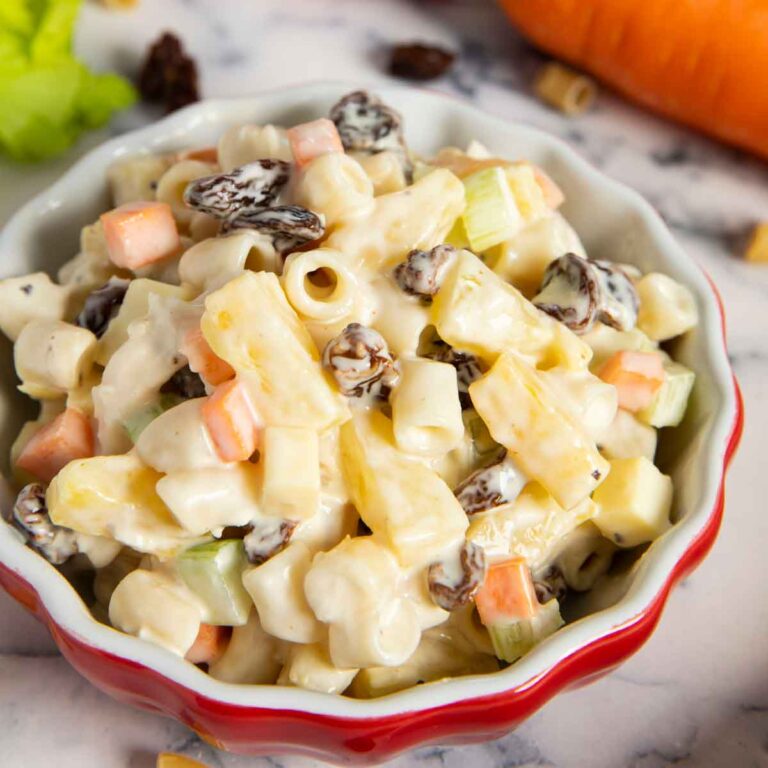Mediterranean Salad with Bulgur Wheat: A Nutritious Middle Eastern Delight
Wanna know how to make that gorgeous bulgur salad you had at your favorite Mediterranean restaurant? you’re in for a treat.
This hearty grain salad has been a staple in Middle Eastern kitchens for generations, and honestly, it’s one of those dishes that gets better every time you make it.
The process is straightforward – you soak bulgur wheat until it’s perfectly tender, then fold in crisp vegetables, fresh herbs, and a simple lemon dressing that brings everything together.
I always prefer coarse bulgur (#2 grade works best) because it holds its shape beautifully and gives you that satisfying chew.
The real magic happens when you let it sit for a while – the flavors marry together in the most wonderful way, making it perfect for meal prep or when you’re hosting friends.

Recipe Information
| Detail | Time/Info |
|---|---|
| Prep Time | 25 minutes |
| Cook Time | 15 minutes |
| Total Time | 40 minutes |
| Course | Main Dish, Side Dish |
| Cuisine | Mediterranean, Middle Eastern |
| Servings | 4-6 people |
Ingredients List
| Ingredient | 4 Servings | 6 Servings | 8 Servings | Alternatives |
|---|---|---|---|---|
| Coarse bulgur wheat | 1 cup | 1½ cups | 2 cups | Quinoa, freekeh |
| Hot water | 1½ cups | 2¼ cups | 3 cups | Vegetable broth |
| Roma tomatoes | 3 large | 4 large | 5 large | Cherry tomatoes, heirloom |
| English cucumber | 1 medium | 1 large | 2 medium | Persian cucumber |
| Red onion | ½ medium | ¾ medium | 1 medium | Green onions, shallots |
| Fresh parsley | 1 cup chopped | 1½ cups chopped | 2 cups chopped | Fresh cilantro |
| Fresh mint | ¼ cup chopped | ⅓ cup chopped | ½ cup chopped | Fresh dill, basil |
| Extra virgin olive oil | ¼ cup | 6 tablespoons | ½ cup | Avocado oil |
| Fresh lemon juice | 3 tablespoons | ¼ cup | 5 tablespoons | Lime juice |
| Sea salt | 1 teaspoon | 1½ teaspoons | 2 teaspoons | Kosher salt |
| Black pepper | ½ teaspoon | ¾ teaspoon | 1 teaspoon | White pepper |
| Feta cheese | ½ cup crumbled | ¾ cup crumbled | 1 cup crumbled | Goat cheese, ricotta |
Cooking Instruments Needed
- Large mixing bowl – Glass or ceramic preferred for marinating (alternative: stainless steel bowl)
- Fine-mesh strainer – For draining bulgur wheat (alternative: cheesecloth-lined colander)
- Sharp chef’s knife – For precise vegetable dicing (alternative: santoku knife)
- Cutting board – Wood or plastic (alternative: glass cutting board)
- Measuring cups and spoons – For accurate ingredient portions (alternative: digital kitchen scale)
- Whisk or fork – For dressing preparation (alternative: small jar for shaking)
- Serving spoons – For tossing and serving (alternative: wooden spoons)
- Airtight container – For storage (alternative: plastic wrap over bowl)
How to Make Mediterranean Bulgur Wheat Salad

Lets go for the process.
Step 1: Prepare the Bulgur Wheat Foundation
Begin by measuring your coarse bulgur wheat into a large mixing bowl. The grade matters significantly here – coarse bulgur (#2 or #3) provides the ideal chewy texture that holds up well against the vegetables and dressing.
Pour hot water over the bulgur, ensuring it’s completely submerged with about an inch of water above the grain level. The water temperature should be just below boiling to properly soften the wheat without making it mushy.
Cover the bowl with a clean kitchen towel and set aside for 15-20 minutes. During this time, the bulgur will absorb the water and expand to nearly double its original size.
After the soaking period, drain any excess water through a fine-mesh strainer and fluff the bulgur with a fork.
The grains should be tender but still maintain a slight bite – this texture contrast is what makes the salad satisfying.
Step 2: Prepare the Fresh Vegetables
While the bulgur soaks, focus on preparing your vegetables with precision.
Start with the Roma tomatoes, which are preferred for their firm flesh and lower water content compared to other varieties. Remove the stem area and dice the tomatoes into uniform ¼-inch pieces, discarding the seeds if you prefer a less watery salad.
For the cucumber, choose English or Persian varieties as they have fewer seeds and thinner skins. Dice the cucumber into pieces similar in size to your tomatoes to ensure even distribution and consistent bites.
The red onion should be finely minced to provide flavor without overwhelming the other ingredients. Soak the minced onion in cold water for 10 minutes to mellow its sharpness, then drain and pat dry with paper towels.
Step 3: Prepare the Herb Mixture
Fresh herbs are the soul of this Mediterranean salad, so proper preparation is crucial. Wash the parsley and mint thoroughly in cold water, then pat completely dry with paper towels or use a salad spinner.
Wet herbs will dilute the dressing and make the salad soggy. Remove thick stems from the parsley, keeping only the tender stems attached to leaves.
Chop the parsley finely but not to a powder – you want to maintain some texture.
The mint should be chopped more coarsely than the parsley, as its flavor is more concentrated.
Roll the mint leaves tightly and use a chiffonade technique for even strips. The herb ratio should favor parsley heavily, with mint providing aromatic accents rather than dominating the flavor profile.
Step 4: Create the Lemon-Olive Oil Dressing
In a small bowl, whisk together the fresh lemon juice, sea salt, and black pepper until the salt dissolves completely.
The lemon juice should be freshly squeezed for the brightest flavor – bottled juice lacks the vibrant acidity that makes this dressing sing. Slowly drizzle in the extra virgin olive oil while whisking constantly to create a temporary emulsion.
The quality of olive oil makes a noticeable difference here, so choose a fruity, well-balanced variety rather than a harsh or overly peppery one.
Taste the dressing and adjust the acid-to-oil ratio according to your preference. Some prefer a more acidic dressing, while others enjoy a richer, oil-forward version.
Step 5: Combine and Marinate
Add the cooled bulgur wheat to a large serving bowl, breaking up any clumps with your fingers. Incorporate the diced tomatoes, cucumber, and drained red onion, mixing gently to distribute evenly.
Pour the prepared dressing over the bulgur and vegetables, then use clean hands or large spoons to toss everything together thoroughly. The bulgur should glisten with the dressing, and every grain should be coated.
Add the chopped herbs and crumbled feta cheese, folding them in gently to prevent the cheese from breaking down completely.
Cover the bowl and refrigerate for at least 30 minutes, though the salad improves significantly after 2-3 hours as the flavors meld together.
Step 6: Final Assembly and Seasoning
Before serving, remove the salad from the refrigerator and let it come to room temperature for about 15 minutes.
This allows the flavors to open up and the olive oil to return to its liquid state if it has solidified.
Taste and adjust seasonings – you may need additional lemon juice for brightness, salt for flavor enhancement, or olive oil for richness.
The salad should be vibrant and balanced, with no single element overpowering the others. Give it a final gentle toss to redistribute the dressing and serve immediately.
Serving and Decoration Tips
- Garnish with whole mint leaves – Place fresh mint sprigs around the bowl’s edge for an aromatic and visual appeal
- Add pomegranate seeds – Sprinkle ruby-red arils over the top for color contrast and sweet-tart flavor bursts
- Serve with warm pita bread – Offer toasted pita triangles or warm flatbread on the side for scooping
- Present in individual bowls – Portion into glass bowls and garnish each with a lemon wedge and olive oil drizzle
- Create a Mediterranean mezze spread – Surround the salad with hummus, olives, and roasted vegetables
- Use colorful serving utensils – Wooden or ceramic spoons complement the rustic Mediterranean aesthetic
- Add texture with nuts – Sprinkle toasted pine nuts or chopped almonds just before serving
- Serve at room temperature – This allows all flavors to shine and prevents the olive oil from solidifying
Variations to Try
Greek-Style Mediterranean Bulgur Salad
Transform this basic recipe into a Greek-inspired version by adding Kalamata olives, sun-dried tomatoes, and roasted red peppers.
Replace the feta with aged Greek feta for a sharper flavor profile, and include a pinch of dried oregano in the dressing.
This variation pairs beautifully with grilled lamb or chicken and makes an excellent accompaniment to Greek-style barbecues.
Protein-Packed Mediterranean Bowl
Convert this side dish into a complete meal by adding grilled chicken, chickpeas, or white beans. The protein additions work best when marinated separately in lemon juice and herbs before combining with the bulgur base.
This version becomes a satisfying lunch or dinner option that provides complete nutrition in a single bowl.
Autumn Mediterranean Salad
During cooler months, incorporate roasted butternut squash, dried cranberries, and toasted walnuts.
The sweet squash balances the tangy dressing while the cranberries add chewy texture. This seasonal variation works particularly well for holiday gatherings and potluck dinners.
Spicy Mediterranean Fusion
Add heat and complexity with diced jalapeños, red pepper flakes, and a touch of harissa paste in the dressing.
Include some crumbled goat cheese instead of feta for a creamy counterpoint to the spice.
This variation appeals to those who enjoy bold flavors and international fusion cuisine.
Storing Tips
- Refrigerate in airtight containers – Transfer to glass containers with tight-fitting lids to prevent flavor absorption and maintain freshness
- Consume within 4-5 days – The salad maintains optimal texture and flavor for nearly a week when properly stored
- Store dressing separately if making ahead – For meal prep, keep the dressing in a separate container and combine just before serving
- Refresh before serving – Add a splash of lemon juice and olive oil to revive flavors after refrigeration
- Avoid freezing – The vegetables and bulgur texture deteriorate significantly when frozen and thawed
- Pack for travel in leak-proof containers – Use containers with secure lids for picnics and potluck contributions
- Keep chilled during transport – Use insulated bags or coolers to maintain food safety during longer journeys
Extra Professional Tips
| Pro Tip | Technique | Impact |
|---|---|---|
| Quality Bulgur Selection | Source from Middle Eastern stores for freshness and proper grading | Superior texture and nutty flavor |
| Temperature Control | Serve at room temperature, not cold from refrigerator | Enhances olive oil fruitiness and herb aromatics |
| Texture Testing | Always taste bulgur after soaking – should be tender with slight bite | Prevents mushy or undercooked results |
| Herb Ratio Balance | Use 4:1 ratio of parsley to mint for optimal flavor harmony | Prevents overwhelming mint dominance |
| Tomato Water Prevention | Choose Roma varieties and salt/drain for 10 minutes before adding | Maintains salad consistency and prevents dilution |
| Marination Timing | Allow minimum 2-3 hours for flavor development | Transforms ingredients into cohesive dish |
The real secret to restaurant-quality bulgur salad lies in understanding your ingredients and respecting the process.
I’ve found that bulgur from Middle Eastern markets has much better turnover than what you’ll find in regular grocery stores, which means fresher, more flavorful grain.
Always smell your bulgur before using it – good bulgur has a pleasant, nutty aroma.
Temperature makes a huge difference in how this salad tastes. When you serve it straight from the fridge, the olive oil gets thick and the flavors become muted.
Let it sit on the counter for about 15 minutes before serving, and you’ll taste the difference immediately. The herbs will smell more fragrant, and the olive oil will coat your palate properly.
Don’t rush the marination process either. I know it’s tempting to dig in right away, but this salad truly transforms after a few hours.
The bulgur absorbs all those beautiful flavors, and everything becomes more harmonious. It’s one of those dishes that rewards patience.
Common Mistakes, Solutions & Prevention
| Common Mistake | Problem Caused | Solution | Prevention |
|---|---|---|---|
| Using fine bulgur instead of coarse | Mushy texture, poor mouthfeel | Reduce soaking time to 10 minutes | Buy #2 or #3 grade bulgur specifically |
| Over-soaking the bulgur | Soft, porridge-like consistency | Drain immediately and spread on baking sheet to dry | Set timer for exact soaking time |
| Adding wet herbs | Watery salad, diluted flavors | Pat herbs dry thoroughly with paper towels | Use salad spinner or air-dry after washing |
| Using too much onion | Overwhelming sharp flavor | Soak onion in cold water for 15 minutes | Measure carefully, start with less |
| Serving straight from refrigerator | Muted flavors, thick dressing | Let stand 15-20 minutes before serving | Plan serving time in advance |
| Insufficient seasoning | Bland, uninspiring salad | Add salt gradually, taste frequently | Season in layers during preparation |

bulgur wheat mediterranean salad
A vibrant, nutritious salad featuring tender bulgur wheat mixed with fresh tomatoes, cucumber, herbs, and feta cheese in a bright lemon-olive oil dressing.
Inspired by: Traditional Middle Eastern tabbouleh and Mediterranean mezze spreadsIngredients
- 1 cup coarse bulgur wheat
- 1½ cups hot water
- 3 large Roma tomatoes
- 1 medium English cucumber
- ½ medium red onion
- 1 cup chopped fresh parsley
- ¼ cup chopped fresh mint
- ¼ cup extra virgin olive oil
- 3 tablespoons fresh lemon juice
- 1 teaspoon sea salt
- ½ teaspoon black pepper
- ½ cup crumbled feta cheese
Instructions
- Prepare Bulgur BaseSoak bulgur in hot water for 15-20 minutes until tender, then drain excess water
- Prep VegetablesDice tomatoes, cucumber, and onion into uniform small pieces
- Make DressingWhisk lemon juice with salt and pepper, slowly add olive oil while whisking
- Combine EverythingMix drained bulgur with vegetables, herbs, and dressing thoroughly
- Add Final TouchesFold in crumbled feta cheese gently to prevent breaking
- Marinate and ServeRefrigerate for 2-3 hours, then bring to room temperature before serving
Notes
- Best served at room temperature for optimal flavor
- Salad improves significantly after marinating for several hours
- Can be prepared up to 3 days in advance
- Store in airtight containers in refrigerator
- Add fresh herbs just before serving if making ahead
- Roma tomatoes work better than beefsteak varieties for less water content
- Quality of olive oil significantly impacts final taste
Frequently Asked Questions
Can I substitute the bulgur wheat with other grains?
While bulgur provides the authentic texture and nutty flavor, you can substitute it with quinoa, freekeh, or even couscous.
Quinoa requires different preparation – rinse it thoroughly and cook in a 2:1 water ratio for 15 minutes.
Freekeh offers a similar chewy texture and smoky flavor that works beautifully in this application. If using couscous, pour boiling water over it and let it steam for 5 minutes, then fluff with a fork.
Each grain brings its own nutritional profile and flavor characteristics to the dish.
How can I make this salad more protein-rich for a complete meal?
Transform this side dish into a protein-packed main course by incorporating cooked lentils, chickpeas, or white beans.
Marinate the legumes separately in lemon juice, olive oil, and herbs before mixing them in. Grilled chicken, lamb, or fish also work wonderfully – dice the cooked protein and fold it in during the final assembly.
For vegetarian options, consider adding hemp seeds, toasted nuts, or even hard-boiled eggs chopped into the mix.
What’s the best way to transport this salad for picnics or potlucks?
Pack the salad in a leak-proof container with a tight-fitting lid, and consider bringing extra dressing in a separate small container to refresh the flavors.
Keep the salad chilled in an insulated bag with ice packs, as the mayonnaise-free dressing is more stable than dairy-based alternatives.
If transporting for several hours, pack the feta cheese separately and add it just before serving to prevent it from breaking down and making the salad soggy.
How do I prevent the tomatoes from making the salad watery?
Choose Roma or paste tomatoes rather than beefsteak varieties, as they contain less water and more flesh.
After dicing, you can salt the tomatoes lightly and let them drain in a colander for 15 minutes before adding them to the salad. Some cooks prefer to remove the seeds and gel from the tomatoes entirely.
Additionally, adding the tomatoes last and serving the salad within a few hours helps maintain optimal texture.
Can I make this salad completely ahead of time, and how does it change over time?
This salad actually improves with time as the flavors meld together. You can prepare it up to 3 days in advance, though the texture will soften slightly.
For best results when making ahead, slightly undercook the bulgur so it maintains more bite after marinating.
Store in the refrigerator and add fresh herbs just before serving if you want maximum herbal brightness.
The salad will continue to absorb the dressing, so you might need to add a splash of lemon juice and olive oil before serving.
Let’s Make This Mediterranean Delight Together
This Mediterranean salad with bulgur wheat brings the sunny flavors of the Mediterranean coast straight to your table.
The combination of nutty bulgur, fresh vegetables, and aromatic herbs creates a dish that’s both satisfying and refreshing. Whether you’re serving it as a light lunch, a side dish for grilled meats, or part of a mezze spread, this versatile salad adapts to any occasion.
Try making it this weekend and share your experience in the comments below – I’d love to hear about your favorite variations and serving suggestions!






